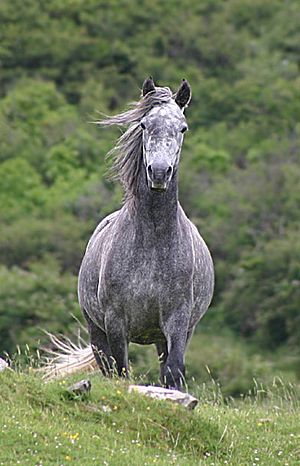Hobelar facts for kids
Hobelars were a special kind of soldier from the Middle Ages in Western Europe. They were like light cavalry, meaning they rode horses, but sometimes they also fought on foot. Their main job was to scout ahead, gather information, and make quick attacks, which is called skirmishing. These unique soldiers first appeared in Ireland in the 1200s. They usually rode small, quick horses known as hobbies.
Contents
Where Did Hobelars Come From?
Many historians believe that hobelars first appeared in Ireland. During the Middle Ages, battles in Ireland often took place in tricky areas like bogs and thick woods. Heavy knights on large, armored horses found it hard to move around in these places.
This is where the hobelar came in! They were a perfect fit for the Irish landscape. Hobelars were very fast and good at scouting, looking for enemies, and patrolling. They could move quickly through difficult terrain. Because of this, they became a common part of the Anglo-Norman armies in Ireland. It wasn't long before other armies, especially in England, started using them too.
However, some historians have a different idea. They think hobelars might have come from an older type of soldier called a muntator. These muntators were used by Anglo-Welsh armies that invaded Ireland in the 1100s. Even with this idea, most agree that the hobelar became its own distinct type of soldier in the 1200s. They became lighter armed, perhaps because it was cheaper. So, hobelars are still seen as a special kind of soldier that developed because of the unique fighting conditions in Ireland.
How Were Hobelars Used in War?
Hobelars were very successful soldiers. Both sides used them during the Wars of Scottish Independence. Edward I of England even tried to stop Ireland from selling hobbies (their special horses) to Scotland. This shows how important these horses and their riders were!
Robert the Bruce, the Scottish king, used hobbies for his guerilla warfare tactics. His hobelars could ride incredibly fast, sometimes covering 60 to 70 miles (about 95 to 110 kilometers) in a single day! People in Ireland and Britain knew how valuable and skilled hobelars were. King Edward I was very impressed by them. He used many Irish hobelars in Scotland and even bought six for his own personal use.
The first time hobelars are mentioned in records is in 1296. About 260 of them went with Irish troops to Scotland as part of Edward I's army. English hobelars started appearing in records after 1300. Edward I gathered 14 of them in Carlisle in 1301. By 1303, there were almost 500 hobelars in his army of 3,400 soldiers. This shows how much he valued them as light cavalry.
Hobelars quickly became a key part of English armies fighting in Scotland. In the early 1300s, you could find them in all the main border forts. Over time, more and more English soldiers became hobelars, not just Irish ones. For example, in 1319, out of 845 hobelars at the siege of Berwick, most were from England. By the 1320s and 1330s, hobelars were a standard part of English forces across the country.
However, in the 1330s, a new type of soldier started to appear: the mounted archer. These archers rode horses but fought with bows and arrows. By the mid-1300s, mounted archers became more common than hobelars, especially for fighting in other countries. For example, at the siege of Calais in 1346–47, there were 5,000 mounted archers but only 600 hobelars.
Even so, the role of the hobelar became clearer. In 1335, their equipment was officially defined. By 1346, it was decided that a man with a certain amount of wealth (about £10) should be equipped as a hobelar. Hobelars continued to be part of local forces for the rest of the 1300s. They were mentioned less in the 1400s, with the last known reference in 1485.
What Did Hobelars Wear and Carry?
We don't have a perfect description of what the very first Irish hobelars wore. But they might have dressed like other Irish cavalry of that time. This could include a padded jacket called an aketon, a chainmail shirt called a hauberk, and a helmet called a basinet. For weapons, they might have carried swords, knives (called scians), and lances.
Their horses were not armored. The Irish hobelars rode in a unique style, often without a saddle, bridle, or stirrups.
By 1335, the official equipment for an English hobelar was listed. It included a horse, an aketon or plate armor, a basinet or a lighter helmet (palet), a neck guard (gorget), iron gloves (gauntlets), a sword, a knife, and a lance.
The Horses They Rode
The horses hobelars rode were called hobbies. These were native Irish horses, and today, the Connemara pony is a good example of what they might have looked like. Hobbies were usually 12 to 14 hands high (about 122 to 142 cm at the shoulder). Their name might come from the French word 'hobin', which some think came from the Gaelic word 'obann', meaning 'swift'.
Even though hobbies were small, they were not low-quality horses. In 1336, the average value of 11 hobbies used in Scotland was about £6.8. This was a bit less than other warhorses, but two hobbies were valued at £10, which was quite a lot! Another hobby lost in a campaign in Flanders in 1338 was valued at 20 marks (about £13.6s.8d.), showing they could be very valuable.
See also
- Border Reivers
- Irish hobby
- Horses in the Middle Ages
- Horses in warfare
- Connemara pony


